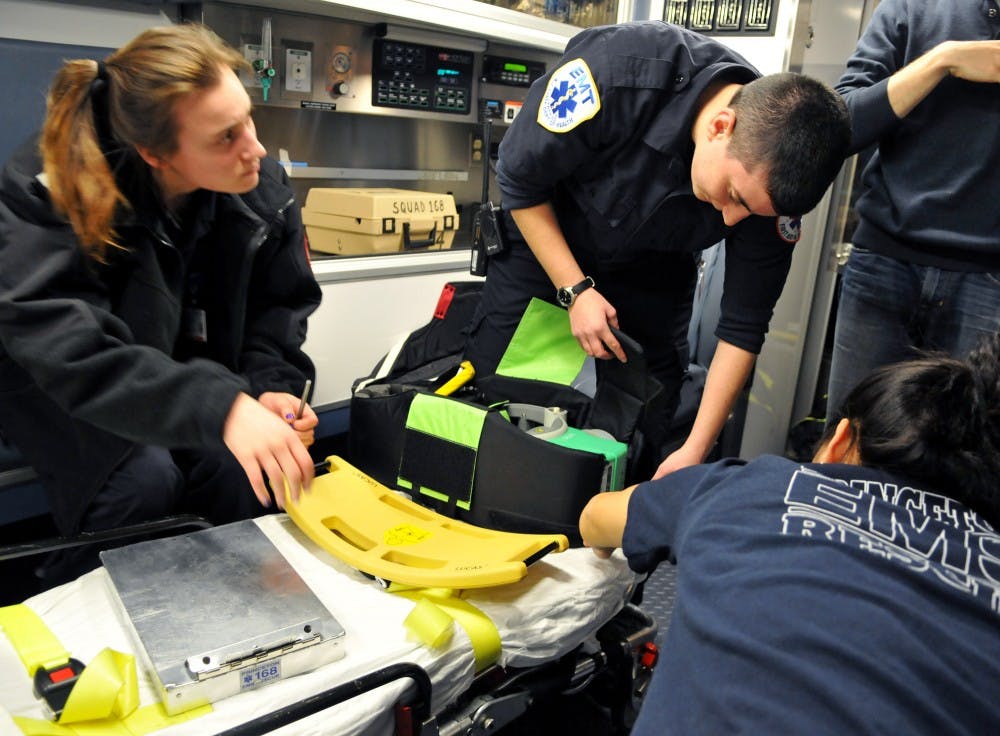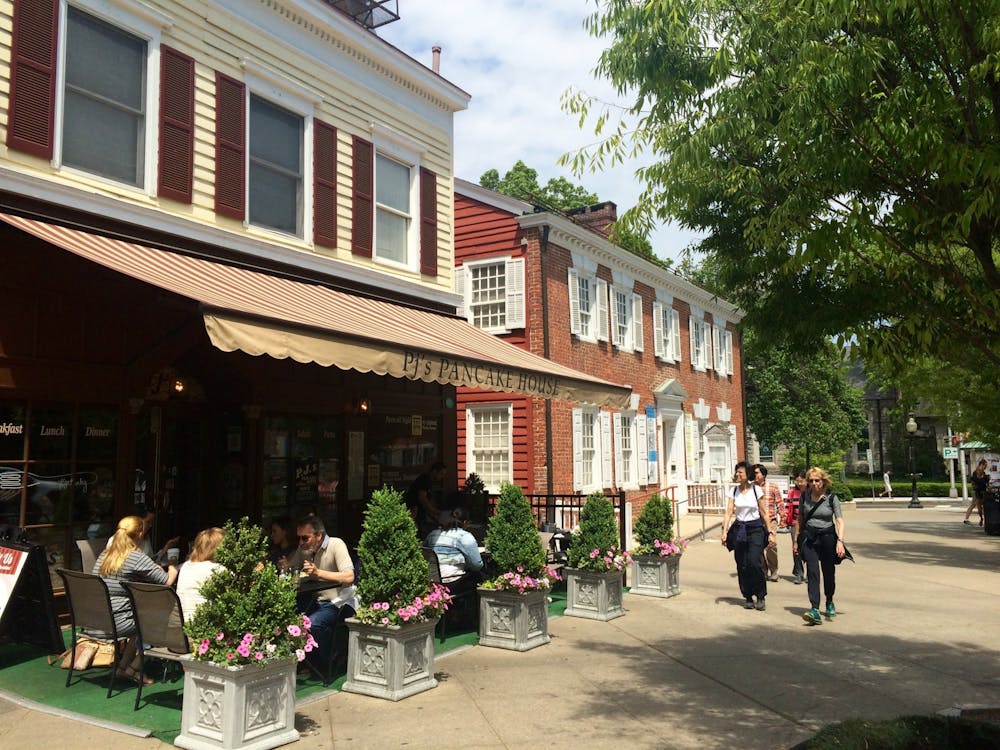At Princeton, the Pace Center for Civic Engagement provides students with the opportunity to train to become emergency medical technicians and join the local rescue squad, treating patients around campus and in the local community. Street caught up with a number of student EMTs recently, many of them squad members for at least three years now, to ask them about what they do and why they do it.
Joining the Squad
“When I was little I got a tour of an ambulance at my grandparents’ house, and I think I must have been five, and I thought it was just so cool, and since then I always knew that I wanted to do that — I wanted to be an EMT,” Lily Adler ’15 said when asked why she decided to become an EMT.
In order to become an EMT, “you need to be certified, so you have to take a class,” Roy Xiao ’14 said. “Luckily, since we have such a large student membership, there are fall and spring semester classes. Most people do it their freshman or sophomore year, but it’s a big investment though, so it’s almost like taking a fifthor sixthclass.”
The commitment doesn’t end there. Members are expected to contribute a minimum of 24 hours a month on duty, plus other various expectations, and shifts are usually between four and 12 hours in length.
“I don’t think you could do it if you didn’t find it exciting or worthwhile,” said Adler. Xiao agreed, adding, “People with a lot of enthusiasm — they stick around the longest and get the most out of it.”
Why they do it
Aside from childhood infatuation with ambulances and medical vehicles, which many of the members cited, the students have a whole slew of reasons for loving their work. “There is something so cool about being the person getting the call, and you don’t really know what to expect since often the information is vague, so you have to think quickly on your feet and assess the situation in order to make sure that the person gets the best care as fast as possible,” said Adler. “There is no standard call — bleeding could be anything from severe bleeding to a more minor scrape, and it’s up to you to help.”
The members also all agreed that getting to know the Princeton community was an important perk of their job. “I’ve gotten to know the town and people not associated with the University and realized that Princeton is actually pretty big, which I never would have figured out otherwise. And it makes you really feel like you’re doing something important,” Dennis London ’14 said. Xiao classified his time on duty as his “weekly excursion outside of the Orange Bubble, a breath of fresh air.”
The Squad
The students also get to meet the many members of the community who are their coworkers. “One of the best things is that the squad is such a diverse group of people, including community volunteers and paid staff,” Adler said. She loves getting to learn from and interact with the community in this way as well. “The general vibe is very friendly, and sometimes we’ll just sit around and hang out or do training together. And they really care — I’ve heard them debrief a call afterwards, talking about what went well or poorly, trying to figure out if they did the best they could and what they can learn for the future.”
Shayan Rakhit ’14, corresponding secretary for Princeton First Aid & Rescue Squad, said that squads will often go out to eat together and get creative with their downtime. “There’s a game that we play sometimes where we put a little cup in the middle of the table and put something gross in it, like ketchup," Rakhit said. "The first person to say something about the squad has to eat whatever that is. It’s just hard not to talk about the squad.”

Rakhit is also an associate sports editor emeritus for The Daily Princetonian.
What they do
When the EMTs are on duty waiting for a call, the activities vary. They range from doing homework to watching TV to chatting with other crew members or running inventory.
However, once they do get a call, they must be prepared to think fast on their feet. “You really get to see a variety of situations, all sorts of weird things, and you have make decisions and really think on the fly,” Rakhit said.
Adler told a story about having difficulty getting into a house to assist a patient. “We had directions saying there was a spare key, but it wouldn’t open the door, and we kept trying to get in ... We thought we would have to break down the door, but I tried the key one more time, and it ended up working.”
With a job that requires the ability to adapt to any situation on the fly, EMTs find that while classroom learning provides a critical foundation, work in the field requires its own kind of experiential learning. “Taking classes teaches you a good amount, but being on the scene is something else, and you really don’t know anything 'til you’ve been around for a while,” London said.
A critical part of the job is being able to foresee potential risk factors and addressing them before a call even comes in.“A lot of what we do is not just answering but thinking ahead and being prepared, planning what we need or up-staffing if we think that it’s going to be a particularly busy night —for example, if there’s a snowstorm forecast,” Adler said.
Extremes
Speaking of snowstorms got the crew excited, and they reminisced about their experiences with dramatic situations, including the hazardous materials explosion at Frick Chemistry Laboratory, and, more recently, Hurricane Sandy.
“There was a period of time where we actually couldn’t go out during Sandy because the wind was too strong, and the ambulance has a lot of surface area, so it tips easily,” Rakhit said. Despite this, as soon as conditions allowed, they were on the scene. Rakhit recounted an experience trying to get to someone with a broken hip and “talking to the chief trying to figure out which roads to take and literally trying every path possible.” Xiao noted though that although it was an intense experience, he also felt that it was “a bonding time” for the squad.
Safety
Though EMTs have to deal with potentially dangerous and unusual situations fairly frequently, squad safety is an important part of their job. "You don’t want to throw yourself in harm’s way, because having a secondpatient isn’t helpful to anyone," Adler said.
Although it may seem somewhat counterintuitive, one of an EMT's biggest responsibilities is his or her own safety.“The number-one thing is that we go home safe. If we can’t, then no one else can. And we’re doing this to help people,” Rakhit said.
Faced with hurricanes, injuries and ketchup shots, Princeton’s EMTs are constantly thinking on their feet to provide support and care for the community. Despite the possibility of danger, the inevitable sleep deprivation and the major time commitment, student EMTs wouldn’t have their Princeton experience any other way.
“I joined because I knew it was not just a campus thing," Cynthia Wang '14 said. "Our squad covers the whole town, so that gives more opportunity to be involved in our community, and that’s what Princeton is about"








